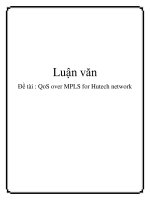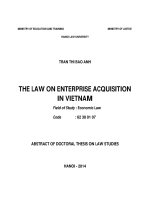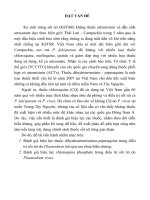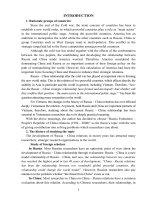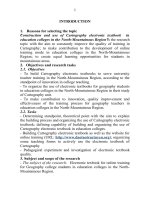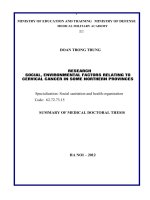Luận án tiếng anh qos over MPLS for hutech network
Bạn đang xem bản rút gọn của tài liệu. Xem và tải ngay bản đầy đủ của tài liệu tại đây (1.25 MB, 77 trang )
Supervisor: Nguyễn Đức Quang
QoS over MPLS for Hutech network
Table of Contents
Architecture of Subject.......................................................................................4
Relation Words ...................................................................................................5
Multiprotocol label switching ............................................................................6
Actuality of MPLS at VietNam..........................................................................6
Advantage of MPLS ...........................................................................................8
Disadvantage of MPLS.......................................................................................8
Icon use in subject ..............................................................................................9
CHAPTER 1: INTRODUCTION ABOUT NETWORK
SYSTEM OF HUTECH UNIVERSITY .................................... 10
1.1. Description about network system of Hutech University. ..........................11
1.2. Important problem and solution. .................................................................11
1.3. Task of subject.............................................................................................12
CHAPTER 2: QOS OVER MPLS NETWORK......................... 13
Part 1: Overview about MPLS .................................................... 14
2.1. Architecture of MPLS packet......................................................................15
2.1.1. Label. ..................................................................................................15
2.1.2. Experimental. ......................................................................................15
2.1.3. Bottom of Stack. .................................................................................15
2.1.4. Time to Live........................................................................................16
2.2. Operating of MPLS network. ......................................................................16
2.2.1. MPLS domain. ....................................................................................16
2.2.2. Ingress and egress node. .....................................................................17
2.2.3. Label Switch Router. ..........................................................................17
2.2.4. Label Switch Path. ..............................................................................18
2.2.5. Forwarding Equivalent Class..............................................................18
Student: Trần Quang Hải Đăng
-1-
Supervisor: Nguyễn Đức Quang
QoS over MPLS for Hutech network
2.2.6. Label Distribution Protocol. ...............................................................19
2.3. Command for configure MPLS ...................................................................20
Part 2: Overview about QoS ....................................................... 22
2.4. Architecture of QoS.....................................................................................23
2.4.1. IntServ model......................................................................................23
2.4.2. DiffServ model....................................................................................25
2.4.3. Different between IntServ model and DiffServ model.......................27
2.5. Classification. ..............................................................................................27
2.6. Marking. ......................................................................................................27
2.7. Queuing tools...............................................................................................28
2.7.1. First In-First Out Queuing. .................................................................29
2.7.2. Priority Queuing..................................................................................31
2.7.3. Custom Queuing. ................................................................................32
2.7.4. Weighted Fair Queuing.......................................................................33
2.7.5. Class-Based Weighted Fair Queuing..................................................38
2.7.6. Low-latency Queuing. ........................................................................41
Part 3: QoS over MPLS............................................................... 44
2.8. Relation about IPP, DSCP and MPLS EXP. ...............................................45
2.8.1. IPP.......................................................................................................45
2.8.2. DSCP...................................................................................................46
2.8.3. MPLS EXP..........................................................................................47
2.9. DiffServ with IP packets. ............................................................................48
2.10. DiffServ with MPLS packets. ...................................................................50
2.11. DiffServ Tunneling Modes for MPLS networks.......................................52
2.11.1. Pipe Model. .......................................................................................52
2.11.2. Short-Pipe Model. .............................................................................54
2.11.3. Uniform Model. ................................................................................55
2.12. Steps implement QoS over MPLS.............................................................57
Student: Trần Quang Hải Đăng
-2-
Supervisor: Nguyễn Đức Quang
QoS over MPLS for Hutech network
CHAPTER 3: NETWORK DESIGN AND IMPLEMENT ....... 58
3.1. Building solution for Hutech network.........................................................60
3.1.1. Real model of Hutech network. ..........................................................60
3.1.2. Solution model for Hutech network....................................................61
3.2. Building simulation model to resolve for Hutech network. ........................62
3.2.1. Simulation model. ...............................................................................62
3.2.2. Implement QoS over MPLS in simulation model. .............................64
3.3. Get Result. ...................................................................................................72
Get Result and Define of develop in Subject.............................. 74
References .........................................................................................................75
Index ...................................................................................................................76
Student: Trần Quang Hải Đăng
-3-
Supervisor: Nguyễn Đức Quang
QoS over MPLS for Hutech network
Architecture of subject
Subject includes three chapters:
Chapter 1: Introduction about network system of Hutech University, problem of
Hutech network system, solution to resolve.
Chapter 2: Chapter 2 includes three parts.
Part 1: Overview about MPLS, architecture MPLS packet, operation of MPLS
network, command line for configure MPLS operation.
Part 2: Overview about QoS, architecture of QoS, classification, marking and
queuing tool.
Part 3: QoS over MPLS, relative about IPP, DSCP and MPLS EXP, DiffServ with
IP packet and MPLS packet, DiffServ tunneling mode, steps implement QoS over
MPLS network.
Chapter 3: Network design and implement. Deploy QoS over MPLS, get result
and define of develop in subject.
Student: Trần Quang Hải Đăng
-4-
Supervisor: Nguyễn Đức Quang
QoS over MPLS for Hutech network
Relation Words
IPP
: IP Precedence (value support implement QoS)
DSCP
: Differentiated Services Code Point
MPLS
: Multiprotocol Label Switching
EXP
: Experimental
QoS
: Quality of Service
LSP
: Label Switched Path
LSR
: Label Switched Router
IntServ
:Iintegrated services
DiffServ
: Differentiated Services
LLQ
: Low-latency Queuing
FIFO
: First In – First Out
CQ
: Custom Queuing
WFQ
: Weighted Fair Queuing
CBWFQ
: Class-Based Weighted Fair Queuing
LDP
: Label Distribution Protocol
Student: Trần Quang Hải Đăng
-5-
Supervisor: Nguyễn Đức Quang
QoS over MPLS for Hutech network
Multiprotocol Label Switching
Multiprotocol Label Switching (MPLS) is a standards-approved technology for
speeding up network traffic flow and making it easier to manage. MPLS involves
setting up a specific path for a given sequence of packets, identified by a label put
in each packet, thus saving the time needed for a router to look up the address to
the next node to forward the packet to. MPLS is called multiprotocol because it
works with the Internet Protocol (IP), Asynchronous Transport Mode (ATM), and
frame relay network protocols. With reference to the standard model for a network
(the Open Systems Interconnection, or OSI model), MPLS allows most packets to
be forwarded at the layer 2 (switching) level rather than at the layer 3 (routing)
level. In addition to moving traffic faster overall, MPLS makes it easy to manage a
network for quality of service (QoS). For these reasons, the technique is expected
to be readily adopted as networks begin to carry more and different mixtures of
traffic.
Actuality of MPLS at VietNam
-With VietNam, MPLS deployment are building in communication network at
VNPT head of company VietNam. With VoIP project is deploying, VNPT
established an axle MPLS network with three LSR core. LSRs edge will be
invested and extended at places have large demand as Hai Phong, Quang Ninh at
north, Da Nang, Khanh Hoa…at medium, Binh Duong, Dong Nai, Ba Ria – Vung
Tau…at south. Next, FPT Telecom, Viettel, electricity are taked part and create
competition environment with high QoS and cheap.
- Present, not including companies and foreign office representative, there are a
lot of home companies in finance field, insurance, bank use this service (Bao Viet
insurance company, Dong A bank…). Beside that, arrange state as Ministry of
Finance, customs, treasury, tax associated together by VPN/MPLS.
-VPN/MPLS technology officially deployed, applied and test successfully and
inserted to exploited from 2003 by VDC. 2004, VPN MPLS solution of VDC
Student: Trần Quang Hải Đăng
-6-
Supervisor: Nguyễn Đức Quang
QoS over MPLS for Hutech network
saved up technology information IT Week 14 gold cup and extended to exploited
on all 64 provinces of all the country with trade name VPN/VNN.
- VPN/VNN MPLS solution of VDC apply and deploy to rely on pass and
device technology of Cisco, with target create a network solution safe, security,
slow late and intergrate with each apply as Data, Voice, Video…
Price for first setup: include price for setup and link to MPLS/VNN
Order
Speed
Price for channel
TDNH
(VND/channel/time)
1
2
3
4
5
64 Kbps
128Kbps
1,500,000
5,000,000
5,000,000
20,000,000
20,000,000
Price for setup, link
to network
VPN/VNN(VND/ch
annel/time)
2,000,000
2,000,000
3,000,000
5,000,000
10,000,000
Price for month: (Upcountry price + Service price MPLS/VNN)
Order
Speed
1
2
3
4
5
6
7
8
9
10
11
12
64Kbps
128Kbps
192Kbps
156Kbps
384Kbps
512Kbps
768Kbps
896Kbps
1024Kbps
1536Kbps
2048Kbps
4Mbps
Student: Trần Quang Hải Đăng
Price for channel
TDNH
(VND/port /month)
609,000
875,000
1,104,000
1,370,000
1,705,000
2,114,000
2,600,000
2,886,000
3,171,000
4,394,000
5,112,000
10,224,000
-7-
Price for all
(VND/port /month)
958,000
1,447,000
1,694,000
1,941,000
2,415,000
2,994,000
3,558,000
3,682,000
3,928,000
5,442,000
5,978,000
11,561,000
Supervisor: Nguyễn Đức Quang
13
14
15
16
17
6Mbps
8Mbps
10Mbps
34Mbps
45Mbps
QoS over MPLS for Hutech network
18,914,400
24,536,000
42,173,000
15,758,000
20,529,000
25,661,000
33,034,000
63,964,000
Advantage of MPLS:
-Security (absolute security in core MPLS network and local loop network).
-Flexible (Easy for wire-open).
-Easy for administrator control.
Disadvantage of MPLS:
-VietNam has limit human resource for control MPLS network system.
-Device support MPLS network is limit.
Student: Trần Quang Hải Đăng
-8-
Supervisor: Nguyễn Đức Quang
QoS over MPLS for Hutech network
Icon use in subject
Student: Trần Quang Hải Đăng
-9-
Supervisor: Nguyễn Đức Quang
QoS over MPLS for Hutech network
CHAPTER 1: INTRODUCTION ABOUT NETWORK
SYSTEM OF HUTECH UNIVERSITY
Student: Trần Quang Hải Đăng
- 10 -
Supervisor: Nguyễn Đức Quang
QoS over MPLS for Hutech network
1.1. Description about network system of Hutech University.
Hutech University include three branches, branch 1 at Binh Thanh distinct, branch
2 at Phu Nhuan distinct, and the last branch at Thu Duc distinct. Three branches
join together by Frame-Relay technology. In every branch, include type of faculty:
-Faculty of information technology.
-Faculty of economy.
-Faculty of build.
-Faculty of foreign language.
-Faculty of electron.
In addition, every branch has SQL server, Web Server, FTP Server, Mail Server.
Network diagram
Figure 1.1- Network diagram of Hutech University.
1.2. Important problem and solution.
Hutech University is carrying to enlarge infrastructure. Up to this time, the number
of branch and department are growing a lot. For this reason, network system of
Student: Trần Quang Hải Đăng
- 11 -
Supervisor: Nguyễn Đức Quang
QoS over MPLS for Hutech network
Hutech University is old and stunted. This network system can’t satisfy need to
communication information between branches. Network system has limit
bandwidth and old technology, so obstruct at any time in network system.
To make good that problem, solution for Hutech University network system must
a new technology, high effect, low cost. We have too much solutions, and the best
solution is QoS over MPLS.
1.3. Task of Subject.
With Hutech’s problem, we will build technology QoS over MPLS for Hutech
network. We design and implement to preference for important traffic, example
video traffic, voice traffic… To limit obstruct.
Model solution for Hutech network:
Figure 1.2 – Solution model for Hutech network
Student: Trần Quang Hải Đăng
- 12 -
Supervisor: Nguyễn Đức Quang
QoS over MPLS for Hutech network
CHAPTER 2: QOS OVER MPLS NETWORK
Student: Trần Quang Hải Đăng
- 13 -
Supervisor: Nguyễn Đức Quang
QoS over MPLS for Hutech network
PART 1: OVERVIEW ABOUT MPLS
Student: Trần Quang Hải Đăng
- 14 -
Supervisor: Nguyễn Đức Quang
QoS over MPLS for Hutech network
2.1. Architecture of MPLS packet.
MPLS label is a field with 32 bit with hard architecture.
Figure 2.1 - MPLS label architecture.
2.1.1. Label.
Label include 20 bit in header MPLS, their value between 0 to 220–1 and it has
1,048,575 labels. However, 16 value labels first aren’t use. In IP network,
transport packets must use IP source and IP destination, but with MPLS network,
packets are transport by label. Routers use label instead for IP address.
2.1.2. Experimental.
From bit 20 to bit 22 is exp field, three bits used for quality of services. Exp bit
similar Precedence bit in IP header. In IP network, implement quality of service is
use IP Precedence or DSCP, but with MPLS network is use Experimental.
2.1.3. Bottom of Stack.
Bit 23 BoS (Bottom of Stack) in MPLS header, if label is bottom of stack, it has
value 1, if label isn’t bottom of stack it has value 0.
Figure 2.2 – Label of Stack.
Student: Trần Quang Hải Đăng
- 15 -
Supervisor: Nguyễn Đức Quang
QoS over MPLS for Hutech network
In MPLS network, when transport packets, every router in MPLS network is use
label for forward packets to exactly destination, router is use label table.
2.1.4. Time to Live.
From bit 24 to bit 31 are used for TTL (Time to Live) field. This field similar TTL
field in IP header. If router can’t finds the destination of packet but router is
forwarding that packet, this action will loop. So TTL field make avoid look. When
packet through every router it’s drop 1. When TTL field has value 0, router will
drop it.
2.2. Operating of MPLS network.
2.2.1. MPLS domain.
MPLS domain include two parts:
-Core network (core).
-Edge network (edge).
With cord network, core network operate complete in MPLS network, router
operate in core network will assign label to packet and forward that packet to next
router. With edge network, router in edge network must do two tasks; two tasks
are imposition label and disposition label from packet. In case imposition with
packet through from IP network to MPLS network, packet is imposition label and
that operation is call imposition. With case packet through from MPLS network to
IP network, packet is disposition label and operation is call disposition.
Figure 2.3 - Imposition and Disposition.
Student: Trần Quang Hải Đăng
- 16 -
Supervisor: Nguyễn Đức Quang
QoS over MPLS for Hutech network
2.2.2. Ingress and Egress node.
When packet goes from IP network to MPLS network, packet will assign label.
And operation is call ingress.
When packet goes from MPLS network to IP network, packet will unassigned
label. And operation is call egress.
Both ingress and egress node are edge router.
2.2.3. Label Switch Router.
A label switch router (LSR) is a router that supports MPLS. It is capable of
understanding MPLS labels and of receiving and transmitting a labeled packet on a
data link. Three kinds of LSRs exist in an MPLS network:
Ingress LSRs receive a packet that is not labeled yet, insert a label (stack) in
front of the packet, and send it on a data link.
Egress LSRs receive labeled packets, remove the label(s), and send them on a
data link. Ingress and egress LSRs are edge LSRs.
Intermediate LSRs receive an incoming labeled packet, perform an operation
on it, switch the packet, and send the packet on the correct data link.
An LSR can do the three operations: pop, push, or swap.
It must be able to pop one or more labels (remove one or more labels from the top
of the label stack) before switching the packet out. An LSR must also be able to
push one or more labels onto the received packet. If the received packet is already
labeled, the LSR pushes one or more labels onto the label stack and switches out
the packet. If the packet is not labeled yet, the LSR creates a label stack and pushes
it onto the packet. An LSR must also be able to swap a label. This simply means that
when a labeled packet is received, the top label of the label stack is swapped with a
new label and the packet is switched on the outgoing data link.
An LSR that pushes labels onto a packet that was not labeled yet is called an
imposing LSR because it is the first LSR to impose labels onto the packet. One
that is doing imposition is an ingress LSR. An LSR that removes all labels from
Student: Trần Quang Hải Đăng
- 17 -
Supervisor: Nguyễn Đức Quang
QoS over MPLS for Hutech network
the labeled packet before switching out the packet is a disposing LSR. One that
does disposition is an egress LSR.
2.2.4. Label Switch Path.
A label switched path (LSP) is a sequence of LSRs that switch a labeled packet
through an MPLS network or part of an MPLS network. Basically, the LSP is the
path through the MPLS network or a part of it that packets take. The first LSR of an
LSP is the ingress LSR for that LSP, whereas the last LSR of the LSP is the egress
LSR. All the LSRs in between the ingress and egress LSRs are the intermediate
LSRs.
Figure 2.4- Label Switch Path
2.2.5. Forwarding Equivalent Class.
A Forwarding Equivalence Class (FEC) is a group or flow of packets that are
forwarded along the same path and are treated the same with regard to the
forwarding treatment. All packets belonging to the same FEC have the same label.
However, not all packets that have the same label belong to the same FEC, because
their EXP values might differ; the forwarding treatment could be different, and they
could belong to a different FEC. The router that decides which packets belong to
which FEC is the ingress LSR. This is logical because the ingress LSR classifies
and labels the packets. Following are some examples of FECs:
-Packets with Layer 3 destination IP addresses matching a certain prefix.
-Multicast packets belonging to a certain group
Student: Trần Quang Hải Đăng
- 18 -
Supervisor: Nguyễn Đức Quang
QoS over MPLS for Hutech network
-Packets with the same forwarding treatment, based on the precedence or IP
DiffServ Code Point (DSCP) field.
-Layer 2 frames carried across an MPLS network received on one VC or
(sub)interface on the ingress LSR and transmitted on one VC or (sub)interface on
the egress LSR.
-Packets with Layer 3 destination IP addresses that belong to a set of Border
Gateway Protocol (BGP) prefixes, all with the same BGP next hop.
This last example of a FEC is a particularly interesting one. All packets on the
ingress LSR for which the destination IP address points to a set of BGP routes in
the routing table—all with the same BGP next-hop address—belong to one FEC.
It means that all packets that enter the MPLS network get a label depending on
what the BGP next hop is.
2.2.6. Label Distribution Protocol.
To get packets across a label switched path (LSP) through the MPLS network, all
LSRs must run a label distribution protocol and exchange label bindings. When all
the LSRs have the labels for a particular Forwarding Equivalence Class (FEC), the
packets can be forwarded on the LSP by means of label switching the packets at
each LSR. The label operation (swap, push, pop) is known to each LSR by looking
into the LFIB. The LFIB (which is the table that forwards labeled packets) is fed
by the label bindings found in the LIB. The LIB is fed by the label bindings
received by LDP, Resource Reservation Protocol (RSVP), MP-BGP, or statically
assigned label bindings. Because RSVP distributes the labels only for MPLS
traffic engineering and MP-BGP distributes the labels only for BGP routes, you
are left with LDP for distributing all the labels for interior routes. Therefore, all
directly connected LSRs must establish an LDP peer relationship or LDP session
between them. The LDP peers exchange the label mapping messages across this
LDP session. A label mapping or binding is a label that is bound to a FEC. The
Student: Trần Quang Hải Đăng
- 19 -
Supervisor: Nguyễn Đức Quang
QoS over MPLS for Hutech network
FEC is the set of packets that are mapped to a certain LSP and are forwarded over
that LSP through the MPLS network. LDP has four major functions:
-The discovery of LSRs that are running LDP
-Session establishment and maintenance
-Advertising of label mappings
-Housekeeping by means of notification
When two LSRs are running LDP and they share one or more links between them,
they should discover each other by means of Hello messages. The second step is
for them to establish a session across a TCP connection. Across this TCP
connection, LDP advertises the label mapping messages between the two LDP
peers. These label mapping messages are used to advertise, change, or retract label
bindings. LDP provides the means to notify the LDP neighbor of some advisory
and error messages by sending notification messages.
2.3. Command for configure MPLS.
Command used for configure MPLS operate
Command used for verify MPLS operate
Student: Trần Quang Hải Đăng
- 20 -
Supervisor: Nguyễn Đức Quang
Student: Trần Quang Hải Đăng
QoS over MPLS for Hutech network
- 21 -
Supervisor: Nguyễn Đức Quang
QoS over MPLS for Hutech network
PART 2: OVERVIEW ABOUT QOS.
Student: Trần Quang Hải Đăng
- 22 -
Supervisor: Nguyễn Đức Quang
QoS over MPLS for Hutech network
2.4. Architectures of QoS.
There are three part for enforce QoS :
-QoS in a environment single network (as arrange sequence, make lists
sequencing and tools for transmit information on network).
-The technique transmit signal for regulate QoS among factors into network.
-The policy QoS, administer, and calculate features for control and manage
transmit information among nodes into network.
2.4.1. IntServ model.
Integrated services (IntServ) defines a different model for QoS than does DiffServ.
IntServ defines a signaling process by which an individual flow can request that
the network reserve the bandwidth and delay needed for the flow. The original
work grew out of the experiences of the IETF in multicasting the audio and video
for IETF meetings in the early to mid-1990s.
Figure 2.5- IntServ model.
Student: Trần Quang Hải Đăng
- 23 -
Supervisor: Nguyễn Đức Quang
QoS over MPLS for Hutech network
IntServ admission control decides when a reservation request should be rejected. If
all requests were accepted, eventually too much traffic would perhaps be
introduced into the network, and none of the flows would get the requested
service. IntServ uses Resource Reservation Protocol for signaling to reserve the
bandwidth. With a full IntServ implementation (more on that later), the originator
of the flow (Hannah) begins signaling. At each router along the route, the router
asks itself, “Can I support this request?” If the answer is yes, it forwards the
request to the next router. Each router holds the bandwidth temporarily, waiting on
the confirmation to flow back to the originator (Hannah). When each router sees
the reserve RSVP command flow back to the originator, each router completes the
reservation. What does it mean for the router to “reserve” something? In effect, the
router reserves the correct queuing preferences for the flow, such that the
appropriate amount of bandwidth is allocated to the flow by the queuing tool.
RSVP can also request a certain (low) amount of delay, but implementing a
guarantee for delay is a little more difficult; IOS, for instance, just reserves the
queuing preference. In fact, IntServ RFCs actually define the term “guarantee” as
a relatively loose goal, and it is up to the actual implementation to decide how
rigorous or general to make the guarantees. RSVP continues signaling for the
entire duration of the flow. If the network changes, or links fail and routing
convergence occurs, the network may no longer be able to support the reservation.
Therefore, RSVP reserves the bandwidth when the flow initializes and continues
to ensure that the flow can receive the necessary amount of bandwidth. IntServ has
some obvious disadvantages, and it has several advantages. IntServ actually
predates DiffServ; DiffServ, to some degree, was developed to provide an
Internet-scale QoS model, because IntServ scales poorly. IntServ expects the hosts
to signal for service guarantees, which brings up two issues—whether the hosts
can be trusted by the network and whether the hosts actually support RSVP.
Alternatively, routers can be configured to reserve bandwidth on behalf of hosts,
but the configuration can quickly become an administrative problem because
Student: Trần Quang Hải Đăng
- 24 -
Supervisor: Nguyễn Đức Quang
QoS over MPLS for Hutech network
additional configuration would need to be added for each reserved flow. Also
IntServ works best when all intermediate networks support IntServ.
2.4.2. DiffServ model.
The DiffServ model designed to repair limits of IntServ model. The DiffServ
model can flexible high and extend large. Instead of perform through QoS and
unity on all line as IntServ model, the Diffserv model perform QoS individually on
each router, so DiffServ unnecessary signal to follow each flow therefore
economize bandwidth and can extend, approprivate with large network model.
Salient features in manage resources of DiffServ model implemented at:
-The DiffServ model don’t implement to signal, shake hand when establish
flow therefore it is losed bandwidth for signal.
-The DiffServ model
manage resource effectly because it don’t reserve
resources for any of a services. Services devided follow sequence priority, which
service has priority higher will provided resource at regime better, when haven’t
flow, the resource will be returned for system and used by other services.
Activity of DiffServ
Activity of DiffServ can describle as follows:
First, information packages classified become a lot of priority group from low to
high according to feature of each service, device will provide authority used
resource more priority, resource will used by lower group if higher group don’t
use.
Student: Trần Quang Hải Đăng
- 25 -
